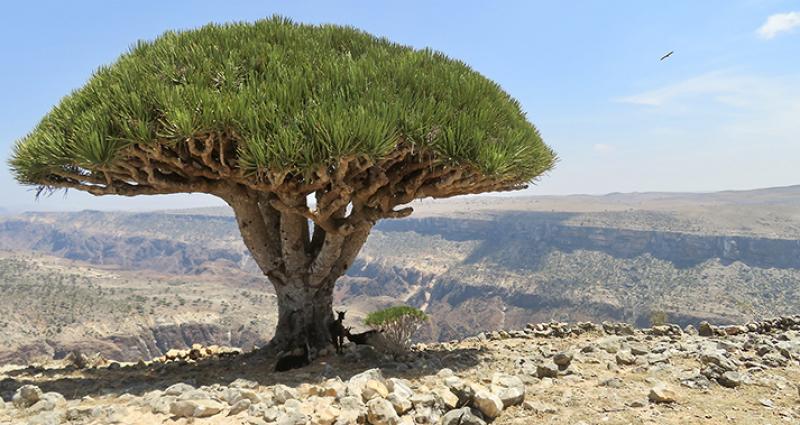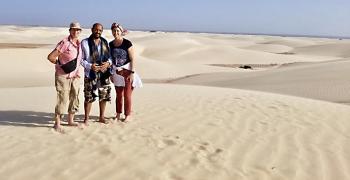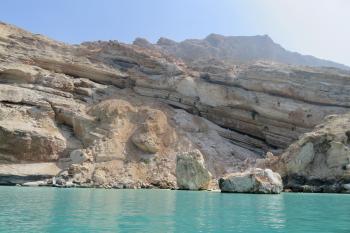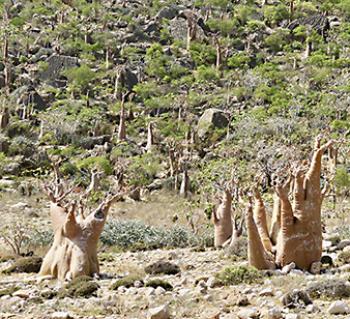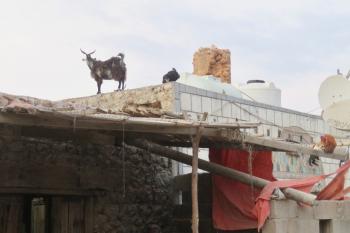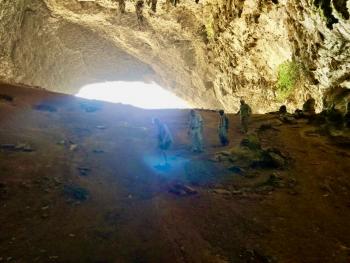Unusual flora in Socotra, Yemen
This item appears on page 14 of the December 2021 issue.
With much anticipation (and a little apprehension), in late February 2020 I set out for a long-awaited adventure to the Arabian Sea islands of Socotra, a small archipelago that is part of Yemen. Located about 150 miles east of Somalia and 240 miles south of the Arabian Peninsula, it is just a speck on a map.
Yemen was one of two United Nations-recognized countries I had yet to step foot in during my 20-plus years of exploring the world. Due to the continuing unrest in mainland Yemen, there have been few opportunities for travel there.
Helping me reach my goal, Spiekermann Travel Service (Eastpointe, MI; 800/645-3233, www.mideasttrvl.com) had mentioned a new Socotra trip that they had planned for late March or early April 2020*. I had never heard of Socotra, but the archipelago is a UNESCO Natural World Heritage Site based on its exceptionally rich biodiversity.
Spiekermann’s trip dates did not fit my schedule, but my husband and I had traveled with the company before, so they agreed to host an exploratory 7-day trip beginning Feb. 26, 2020, with just four travelers, including my daughter Chris and me.
We paid $5,150 per person, double occupancy, which covered arrangements for the Cairo-Socotra-Cairo flights, the visa letter for Yemen (your passport must have no indication of your having visited Israel), accommodations in Cairo and Socotra, an English-speaking guide, transportation, meals and bottled water — just about everything except for gratuities.
At the airport in Cairo, Egypt, we met the other two travelers in our group — affectionally referred to as “the boys” throughout the trip, despite their ages (65 and 80) — and around 3 a.m. on Feb. 26, a Wednesday, we flew from Cairo to Seiyun Airport on the mainland of Yemen for officials to check our passports. We then flew to Hadibo, the largest town on Socotra, the largest of the archipelago’s four islands.
Wednesday was the only day there was a flight to and from Hadibo, and it was a madhouse at the airport when we arrived, since almost everything on the island, including food and living essentials, is imported from the mainland. It seemed half the island was there jockeying for space.
My first impressions in Socotra were of the heat, the rocks and dust, goats, and women in full black burqas or hijabs, while men were in jeans and T-shirts.
The Summerland Hotel in Hadibo was our home for the next week. The hotel was clean, and our room was air-conditioned. We barely had time to put our bags down before we were off to the beach in nearby Delisha. It was a nice way to begin our adventure.
Our transportation was two 4WD SUVs. We were in one with our Yemeni guide, Kais Alkhalisi, and a driver, and in the other SUV was a Socotra guide and the boys. A third SUV carried two cooks, picnic tables and chairs and all the food. Kais had brought, from mainland Yemen, all the food that we were going to eat that week.
•
The next day, we were up early to visit the Diksam preserve. Socotra is a hugely biodiverse island because it has been isolated for so long and has a unique climate. The endemic fauna and flora is very unusual.
Two alien-looking plant species we saw were the desert rose, or bottle tree, and the umbrella-like dragon’s blood tree. With these remarkable trees (found nowhere else on Earth) growing on rocky soil atop a limestone plateau, the landscape is amazing.
At the bottom of a valley in the preserve, we hiked to a small freshwater pool. The heat was intense and the trail, a dry creek bed, rugged. The pool was lovely, though, and we changed into our swimsuits (behind a rock) for a relaxing cooling off.
It was late when we got back to the hotel, so we went to a nearby restaurant for dinner. Outings in the evening were always a little unnerving, since women largely disappear from public view after their morning trips to the market. My daughter and I felt very conspicuous out among the Yemeni men in the evenings.
• On day three, we set out for the Homhil Protected Area, a plateau. Our guide to the top was a 13-year-old boy. To say this hike was difficult is an understatement. It took us two hours to trek 1½ miles. We were scrambling over tumbled boulders and hanging onto tree roots to pull ourselves up a mountainside.
Thankfully, we had plenty of water, and we made lots of stops to rest. The greenery was interesting, and the views were amazing.
At the top, a natural “infinity pool,” fed by a spring, was well worth the climb. We relaxed in the water, gazed upon the Arabian Sea below and tried to teach Kais to swim.
• The next day started with a cross-island drive on what began as a dirt road but soon became a mostly dry creek bed. We stopped for lunch at the Wadi Difarhur, in Wadi Dirhir. There was another little pool, which the boys took advantage of for swimming.
After every meal, waiting for our lunch leftovers were goats and Egyptian vultures. We also saw the endemic Socotra sparrow and Socotra bunting.
When we reached the north side of the island, all of a sudden we were at the white Zahik sand dunes, which reach as tall as 300 meters. The wind brings the sand from the Horn of Africa, creating spectacular undulating waves as far as the eye can see. Their beauty was breathtaking, and we wandered over the dunes in our bare feet to feel the coolness of the sand between our toes!
From there, we drove to Digub Cave, where we had an easy (compared to others) 15-minute hike to the entrance of the impressive cave. It had a very large and wide opening, and there were many stalactites hanging from the ceiling. Locals use the cave as a picnic spot and sometimes keep goats in part of it.
• On day five we obtained another 13-year-old guide and began another strenuous hike, this time to the 3-kilometer-deep Hoq Cave. It was stiflingly hot during the 2-hour uphill hike but amazingly cool and still inside the cave, where we were awe-struck at the amazing stalactites and stalagmites at the entrance.
Donning our headlamps, we began to explore. There were so many different formations and colors everywhere. We spent about an hour inside the cave, although only the 80-year-old in our group hiked to its end and back.
• Day six had us driving an hour or so to the fishing village of Qalansiyah, where we motored out to sea on a traditional fisherman’s skiff. We were amazed at the absolute beauty of the area — the towering cliffs along the shoreline and the remarkably clear turquoise water. We didn’t see any fish, but there were cormorants, terns and herons on the cliffs.
At Shoab Beach, we put on our swimsuits and enjoyed the magnificent water.
• The morning of day seven found us snorkeling at the Di Hamri Marine Reserve. We could just float to our hearts’ content and watch a multitude of all types, sizes and colors of fish, including large schools, all very close to the shore.
In the afternoon, we spent some time in Hadibo. The children were just getting out of school, and several approached us for a handshake and a smile. They were very friendly. There were more women out and about than we had seen before, covered except for their eyes. We went to several stores to shop. If there were ladies’ garments in an area in a store, Chris and I were the only ones allowed in that area.
•
All week, the meals had been delicious and nutritious. There was always a salad, cooked vegetables, rice or pasta, chicken or goat or fish and bread plus plenty of water and hot apple tea. During drives, fruit drinks and water were available in the SUV.
Unfortunately, with the need for bottled drinks on the island, the discarded plastic lay many inches deep in the streets, and it dotted the otherwise breathtaking landscape. Since goats eat the plastic, goats meant for consumption are found only in rural areas, where they have a more normal diet.
We returned to the United States just as the pandemic was beginning to be in full swing, but that is not the least of the problems in Yemen.
Yemen has been in a civil war since 2014, though the actual fighting has been mostly on the mainland. In Socotra, we saw flags of Yemen, of the UAE-backed separatist Southern Transitional Council and of Iran-backed Houthi rebels.
Depending on where we were on the roads in Socotra, we could go through a checkpoint with soldiers from one of these groups, only to be slowed 20 minutes later by a different group. We just passed on by and there were no problems, but it was interesting to see all these soldiers just a few miles apart.
The politics are very confusing, with so many different factions and external forces trying to take control of the Arab world’s poorest country, one dealing not only with corruption, infighting and geopolitical schemes but cholera, malaria, malnutrition and now COVID-19.
All I can say is I feel so fortunate to have had the opportunity to visit. My advice for travel is, whenever the opportunity arises, no matter the destination, go for it, for the chance may not come again.
ALLA CAMPBELL
Greensboro, GA
*There still is space on trips to Socotra with Spiekermann Travel Service, Feb. 7-18 and Nov. 8-19, 2023.

